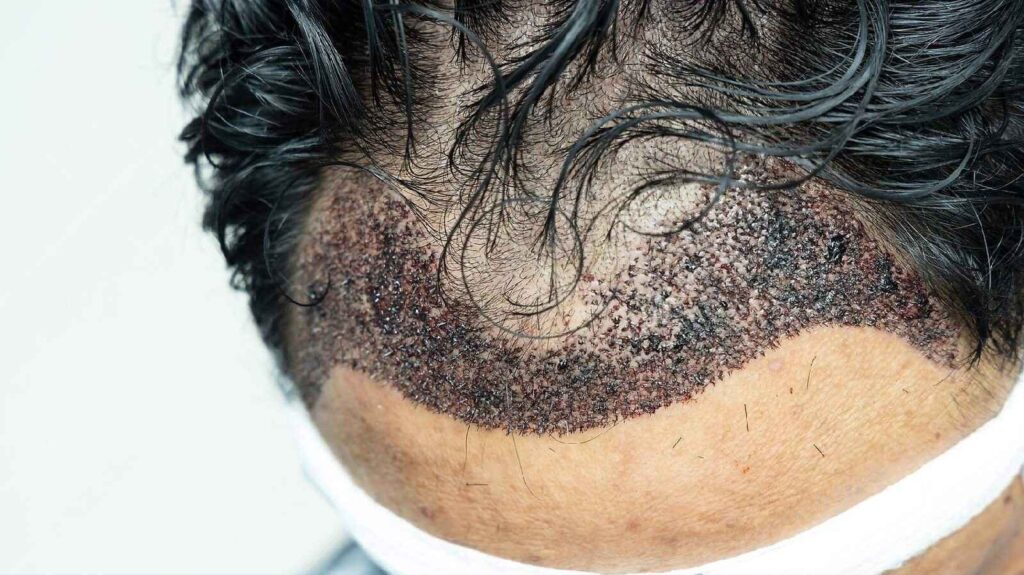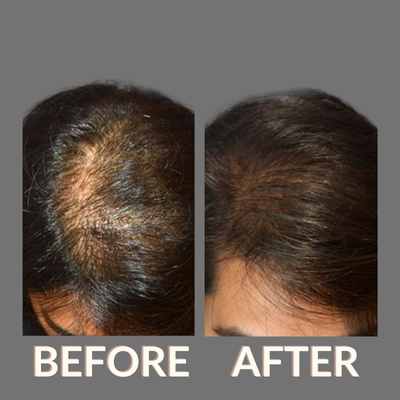Hair Transplant In Nagpur
A very popular cosmetic surgery that tries to stop hair loss or baldness is hair transplantation. Therefore, it is also known as “surgery for hair restoration.” It is the only therapy that can stop hair loss permanently. It entails removing hair follicles from one area of the scalp (also known as the donor area) and transplanting them into the bald area of the scalp (also known as the recipient area). It is a risk-free operation with very little danger. Additionally, the success rate of hair transplant surgery is very high if it is carried out by a skilled hair transplant surgeon.
Understand the hair transplant procedure, expectations, and benefits at Twacha Aesthetic Clinic. Discover how this surgical technique can restore a fuller head of hair, boosting your confidence. Learn more about what to expect during and after this transformative surgery.

The types/ techniques of Hair Transplant
There are mainly two types of hair transplants which are as follows:
- Follicular Unit Transplant (FUT) Or Strip Surgery:- The donor area will have a portion of the skin (often in the shape of a strip) removed, and the incision will be stitched up. The donor skin will then be divided into microscopic follicular units with one or more hair follicles using a microscope, which the doctor will subsequently inject into the appropriate place.
- Follicular unit extraction (FUE):- In this method, tiny punch tools are used to remove hair follicles from the donor area. After this procedure, there will still be some marks, but they will be less noticeable, and stitches are not required.
Nowadays, FUE hair transplant surgery is more popular as it involves no downtime and is minimally invasive.
What Is a Hair Transplant?
A hair transplant is a surgical procedure that involves the removal of hair follicles from one part of the body (usually the back or sides of the head, known as the donor site) and transplanting them to an area where hair growth is sparse or absent (the recipient site). The primary goal of a hair transplant is to restore natural hair growth in areas affected by hair loss or thinning.
Key Components of a Hair Transplant:
Consultation and Assessment:
- The process begins with a thorough consultation where a specialized surgeon assesses your hair loss pattern, scalp condition, and overall health.
Donor Site Harvesting:
- Hair follicles are typically extracted from the back or sides of the head, areas resistant to balding, and genetically predisposed to grow permanent hair. This is done through techniques like follicular unit extraction (FUE) or follicular unit transplantation (FUT).
Recipient Site Preparation:
- The recipient site, where the transplants will be placed, is carefully prepared to ensure optimal growth and a natural appearance.
Hair Follicle Transplantation:
- The harvested hair follicles are then transplanted into the recipient site using tiny incisions, creating a natural hairline and overall aesthetic.
Post-Transplant Care:
- After the procedure, patients receive instructions for post-operative care, including information about cleaning, medication, and avoiding certain activities to promote successful healing and hair growth.
Why do you need a hair transplant?
Hair transplants are aesthetic procedures, so getting one is voluntary, yet demand for them is still growing. It’s because one’s hair plays a big role in defining their personality.
The younger age group of people in their 20s has seen an upsurge in hair loss instances in recent years. Therefore, it is only natural for people to experience anxiety or self-consciousness. Poor lifestyle choices, a lack of vital nutrients for growth, and heredity remain the main causes of early hair loss.
After having hair transplant surgery, one’s attitude and looks both improve, which restores one’s confidence.
The procedure can also be used to regrow hair in regions other than the scalp, such as eyelashes, eyebrows, and beard hair.
Steps involved in the procedure of hair transplant
1. Preparation for the hair transplant surgery:-
- Consultation is the initial action. All of the patient’s concerns and expectations for the hair transplant procedure are understood during the consultation. The patient is able to openly discuss any concerns or questions with the surgeon if they exist. The hair and scalp will also be examined by the hair transplant surgeon.
- Doctors advise a battery of tests before to the operation to ascertain the patient’s fitness for the procedure. Among the tests that will be conducted are blood tests, allergy tests, and liver function tests.
- In order to prevent any surgical complications, the surgeon would also encourage the patient to abide by specific pre-operative instructions, such as abstaining from alcohol and smoking.
- The donor area, whether or not the patient has enough donor hair on the scalp, whether or not the donor hair is to be taken from other body parts like the chest, the type of hair transplant that will be more suitable, and finally whether or not the patient needs multiple sittings in case of extreme hair loss will determine whether a single sitting will produce the desired results. Planning is very important.
- Before the surgery is commenced, the hair in the donor area is trimmed.
- Once the hair in the donor area is completely trimmed, local anesthesia is given so that the patient can rest comfortably while the hair transplant is being done.
2. Hair Follicle Extraction:-
- In the initial stage of hair transplant surgery, hair follicles are removed from the back of the head. These hair follicles are resilient and resistant to going bald.
- In case of FUE, individual hair follicles are extracted.
- In case of FUT, a strip of the skin is cut from the back of the head and the incision is sutured. Then individual hair follicles are extracted for grafting.
3. Grafting the extracted hair follicles:-
- In the tiny incisions that are made in an atypical pattern in the recipient area, follicular unit grafts are inserted. But in reality, it’s not as simple as it seems.
- Grafts are positioned based on their densities. One and two, which are the tiniest grafts, are placed in front of the hairline, and three and four, which are denser than one and two and placed behind.
- In order to get natural results, it is crucial to maintain the direction of natural hair development in mind when grafting the hair follicles.
- Hairline creation is another crucial part of the hair transplant surgery.
- The chances of errors rise and one may not be able to get the desired outcomes when the procedure is carried out by amateurs or technicians rather than a hair transplant surgeon. So it’s crucial to pick the correct hair transplant specialist.
4. After the Hair Transplant Surgery:-
- Following the hair transplant process, the patient’s scalp will have a few tiny incisions and short hair in the area that was operated on.
- In the case of strip surgery, stitches must be entirely removed after 10 days.
- Regular medications need to be taken to alleviate pain and swelling.
- Some medicines will be given to help reduce the risk of infection after the surgery.
- The doctor advises using various medications to promote hair development and prevent hair from falling out again.
- The transplanted hair can again fall after the surgery which might create discomfort for the patient but it is a common phenomenon.
- A satisfactory hair growth is normally achieved after 9-12 months of the surgery.
Advantages of Hair Transplant Surgery
Some advantages of Hair Transplant Surgery are as follows:
- Improved appearance.
- Improved self-esteem & confidence.
- Reduction in the cost of maintaining hair.
- No hospital admission is required for the daycare operation.
- Permanent results.
- No major downtime or recovery period.
Who can benefit from Hair Transplant Surgery?
- Hair transplant surgery is an excellent option for anyone with permanent hair loss, including both male and female pattern baldness.
- A hairline creation procedure is an option for both men and women who want to change the shape of their hairline or restore it.
- Patients who have undergone some hair loss as well as those who have scarring from injuries or “scarring” skin conditions.
- People who desire to thicken the hair growth on their brows, eyelashes, or beard.
How much time does the procedure take?
It usually takes 6 to 8 hours to complete a 1500–3000 graft outpatient treatment. Most patients begin their appointments in the morning and end them by late afternoon.
Are the results long-lasting?
The transplanted hair follicles are from genetically resistant regions, so they will continue to grow for the rest of the patient’s life.
What special care would be needed for transplanted hair?
Absolutely none until the treated region has fully recovered!
The patient can style his or her hair anyway they like once the new hair has fully grown out. Even with natural hair, taking some precautions like avoiding combing wet hair, avoiding using a tight rubber band, and keeping the scalp clean can help maintain healthy hair.
How long does transplanted hair take to grow?
Within the first three months, the patient can often anticipate seeing fresh hair begin to grow. The full extent of the surgical benefits in terms of hair growth can be noticed 9 to 12 months after the procedure. The hair will be longer, heavier in volume, and thicker than it was before. Following a hair transplant, new hair will grow permanently and will keep growing for the rest of your life.
What problems can arise after a hair transplant?
- Bleeding.
- Infection.
- Inflammation of the scalp.
- Itching.
However, a skilled hair transplant surgeon can easily handle each of these.
What constitutes a hair transplant procedure's essential component?
The most important part of the hair transplant operation is hairline planning, which is extremely important for frontal baldness.
When may I resume working and exercising after my procedure?
The very following day, one can report back to work. You should be able to resume exercising after 3 to 4 days. Avoid any activities that aggravate or put too much pressure on the donor area for a few weeks.
What is the cost of a hair transplant procedure?
The price of hair transplant surgery can change depending on the method used, the quantity of grafts to be transplanted, the surgeon’s experience, and other considerations. Visit Twacha Skin at your leisure to get the precise cost.
HAIR LOSS TREATMENTS
BEFORE & AFTER



